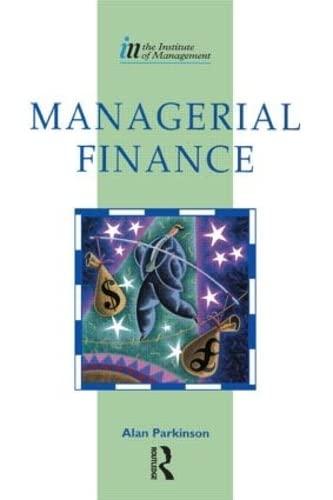

4. Answer the questions 4.1 to 4.4. (Note: your calculations MUST include specifications, formulae, detailed steps, and explanations.) 4.1. Compare, critically, the NPV, IRR and Payback methods of investment appraisal. (250 words; 5 marks) ACF6007 Page 3 of 8 4.2. Plymouth Ltd is evaluating the acquisition of a private company ABC. ABC is assumed to have approximately the same risk as to the public company T. The beta of equity of company T is 1.2 and the Debt-to-Equity ratio is 0.8. The corporation tax rate = 21%. Required return on debt = risk free rate = 3%. Expected return on market portfolio = 8%. Required: (a) Compute the after-tax WACC for the ABC acquisition if Plymouth Ltd is going to maintain its current Debt-to-Equity ratio of 0.5. (4 marks) (b) Explain why the after-tax WACC is lower than the pre-tax WACC. Why isn't it possible for firms to aim to have near 100% debt in their capital structure? (200 words; 4 marks) 4.3. Answer the following questions: (a) BM Ltd has $100,000 in excess cash. BM is considering investing the cash in one- year Treasury bills paying 6% interest, and then using the cash to pay a dividend next year. Alternatively, the firm can pay a dividend immediately and shareholders can invest the cash on their own. In a perfect capital market, which option will shareholders prefer? (3 marks) (b) Critically discuss the agency costs of retaining cash within a firm. (150 words; 3 marks) 4.4. Answer the following questions (a) A financial analyst collects a US public-traded companies' financial information as below (in $1000 units): Sales 12050 Earnings before interest and tax 3559 Retained earnings 2662 Market value of equity 63272 Total Debts 9042 Total assets 28848 Working capital 6660 Required: Is the business safe or not in your opinion? (Hint: Use a formula from your lecture notes.) (2 marks) (b) Discuss how the volatility of the value of assets impacts the probability of default. ACF6007 Page 4 of 8 (Hint: Employ what you learned from the Merton (1974) model. The model is given below.) (4 marks) Pr. def = N In(V/X) + (8 1) T\ x ( - %A VT 4. Answer the questions 4.1 to 4.4. (Note: your calculations MUST include specifications, formulae, detailed steps, and explanations.) 4.1. Compare, critically, the NPV, IRR and Payback methods of investment appraisal. (250 words; 5 marks) ACF6007 Page 3 of 8 4.2. Plymouth Ltd is evaluating the acquisition of a private company ABC. ABC is assumed to have approximately the same risk as to the public company T. The beta of equity of company T is 1.2 and the Debt-to-Equity ratio is 0.8. The corporation tax rate = 21%. Required return on debt = risk free rate = 3%. Expected return on market portfolio = 8%. Required: (a) Compute the after-tax WACC for the ABC acquisition if Plymouth Ltd is going to maintain its current Debt-to-Equity ratio of 0.5. (4 marks) (b) Explain why the after-tax WACC is lower than the pre-tax WACC. Why isn't it possible for firms to aim to have near 100% debt in their capital structure? (200 words; 4 marks) 4.3. Answer the following questions: (a) BM Ltd has $100,000 in excess cash. BM is considering investing the cash in one- year Treasury bills paying 6% interest, and then using the cash to pay a dividend next year. Alternatively, the firm can pay a dividend immediately and shareholders can invest the cash on their own. In a perfect capital market, which option will shareholders prefer? (3 marks) (b) Critically discuss the agency costs of retaining cash within a firm. (150 words; 3 marks) 4.4. Answer the following questions (a) A financial analyst collects a US public-traded companies' financial information as below (in $1000 units): Sales 12050 Earnings before interest and tax 3559 Retained earnings 2662 Market value of equity 63272 Total Debts 9042 Total assets 28848 Working capital 6660 Required: Is the business safe or not in your opinion? (Hint: Use a formula from your lecture notes.) (2 marks) (b) Discuss how the volatility of the value of assets impacts the probability of default. ACF6007 Page 4 of 8 (Hint: Employ what you learned from the Merton (1974) model. The model is given below.) (4 marks) Pr. def = N In(V/X) + (8 1) T\ x ( - %A VT








